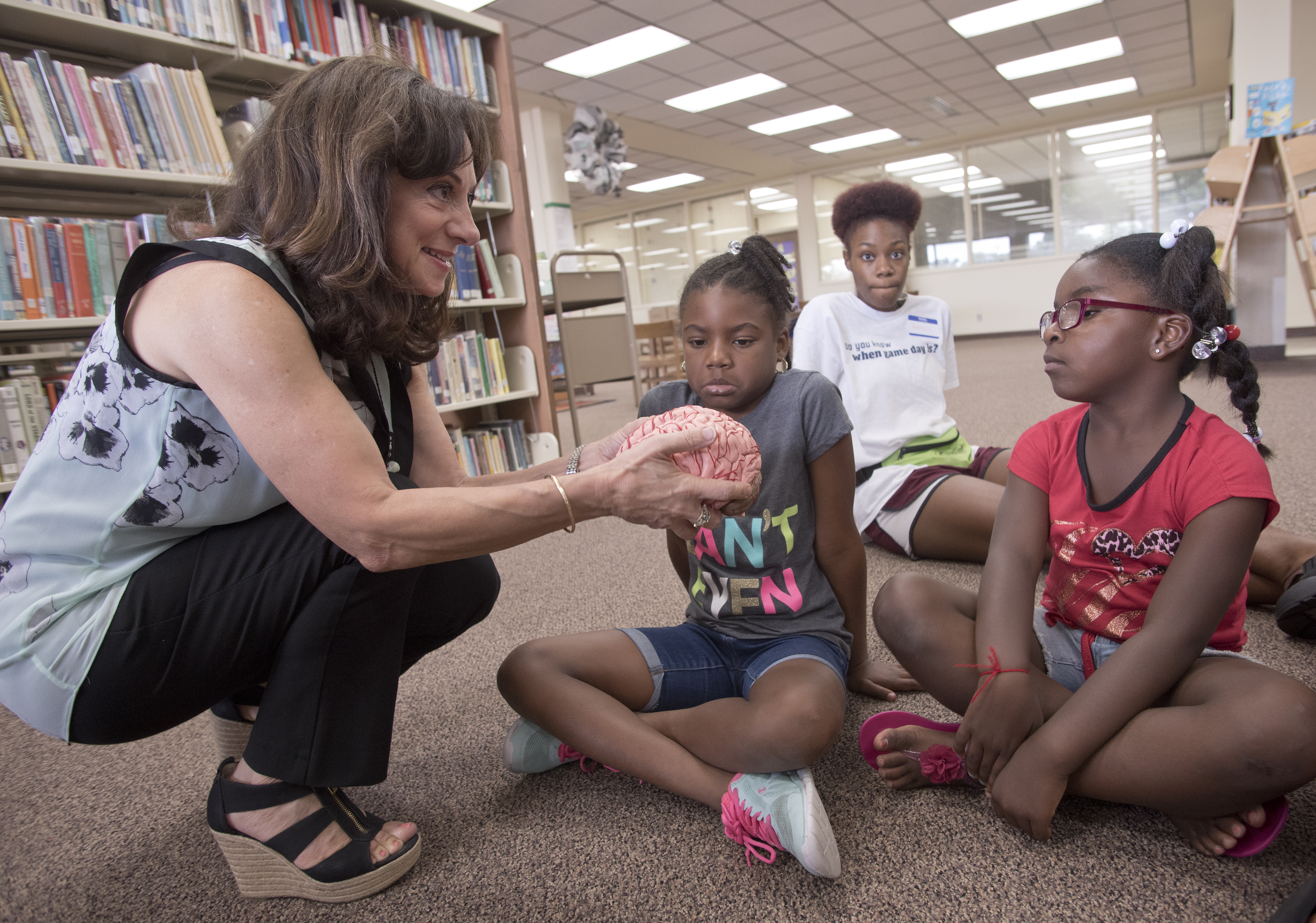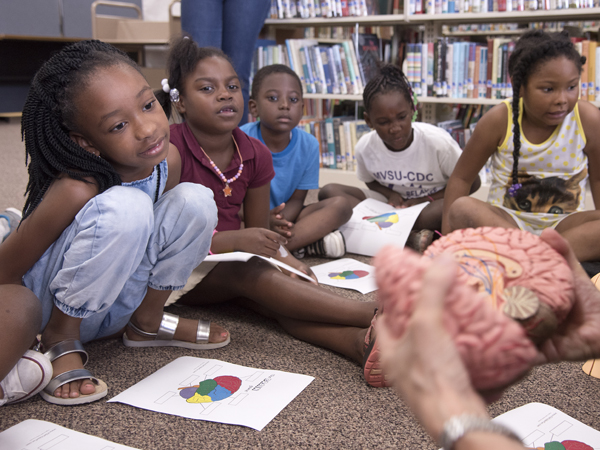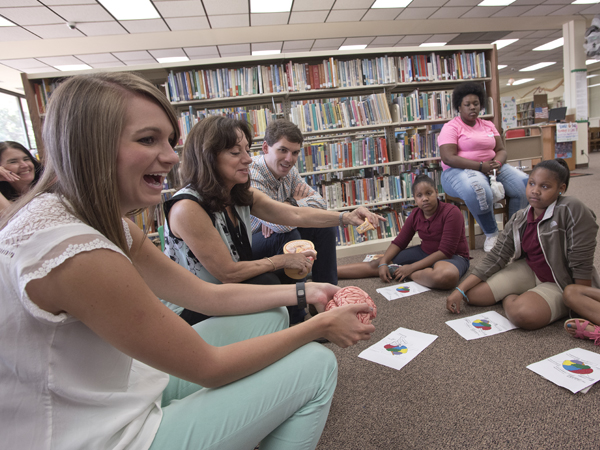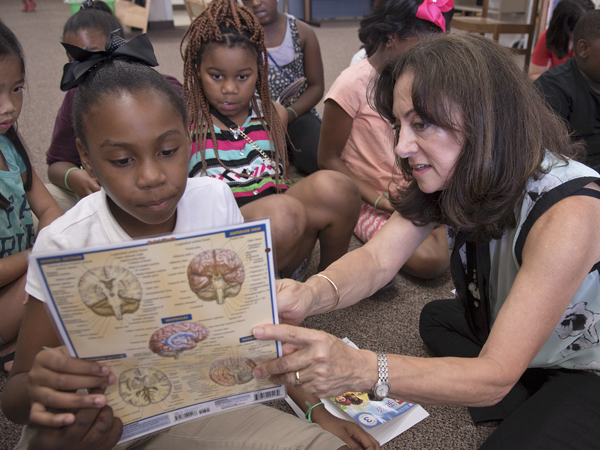Summer program serves up food for thought

Mary Katherine Kearce sat on the floor with her young students for the afternoon.
“If you're a tightrope walker, what do you have to have?” the fourth-year medical student at the University of Mississippi Medical Center, holding out her arms like a circus performer, asked the collection of children at the Greenwood-LeFlore Library.
“Balance!” said Kylei Jackson.
“Yes,” chimed in Dr. Susan Buttross, UMMC professor of pediatrics and medical director of the Center for the Advancement of Youth, “and you can't have balance without the cerebellum.” She pointed to the corresponding part on a model of a brain she passed to the kids, getting oohs and ahhs from the elementary-school audience.
Neal Boone, like Kearce, a fourth-year medical student, fielded questions and distributed worksheets.
The brainy lesson was food for thought for about 50 children who attended Summer Food Rocks, a program volunteers from UMMC ranging from physicians to students help operate.

Organized by the Mississippi chapter of the American Academy of Pediatrics, the program just finished its second year of June afternoons at the Greenwood-Leflore Library following meals provided by the U.S. Department of Agriculture's Summer Food Service Program at other sites in the city.
The USDA program provides healthy lunches on weekdays to low-income children during summer months, when they miss out on breakfasts and midday meals at school.
“Summer Food Rocks is designed to share information with children about healthy eating and how our bodies work,” said Shelonda Henderson, program director of Summer Food Rocks. “They get lessons on healthy living, exercise, arts and crafts; they check out books for summer reading, and they get to try foods they might not normally eat.”
One afternoon, instead of going to potato chips for a crunchy snack, kids were dipping carrots, celery and cucumber in ranch dressing. “And they loved it,” Henderson said.

Summer Food Rocks got its start in 2015, when the national American Academy of Pediatrics wanted to address childhood poverty and obesity, which can happen when lower-income families, to stretch their dollars, buy cheaper foods that are higher in calories than fresh vegetables and lean proteins, which cost more, said Dr. Jonathan Shook, president of the state's AAP chapter and a University of Mississippi School of Medicine alumnus who finished his pediatric residency at UMMC in 2006.
Mississippi's rates of childhood poverty and childhood obesity have been among the highest in the nation, according to U.S. Census Bureau and U.S. Centers for Disease Control and Prevention studies.
Dr. Randy Henderson, a neonatologist at Forrest General Hospital in Hattiesburg and Memorial Hospital in Gulfport and immediate past president of the state AAP chapter, said organizers talked with Greenwood area pediatricians to find out their needs. More nutrition information and improving children's reading skills were on their wish list.
“We wanted to create a summer program to address these areas,” Henderson said, “and we're grateful to UMMC for their physicians' and students' support.”

In different corners of the library on June afternoons, kids jumped rope, painted or won prizes for answering questions such as, “Is it healthier to ride the elevator or walk up the stairs?” Answering “walk up the stairs” got a student a Frisbee.
Beside the bookshelves of adventure stories, feeding the frontal lobe, the temporal lobe and the medulla oblongata was a topic of discussion among Buttross, Kearce, Boone and their students, who ranged in age from 6 to 13.
“Vegetables are really, really good for the brain,” Buttross told the students. “They have lots of vitamins that help the brain work better. Who can name some vegetables?”
Hands shot up and excited children answered: “Carrots!” “Broccoli!” “Tomatoes!” “Celery!”
The importance of other brain-healthy activities, such as running, playing, reading and getting a good night's sleep were discussed, and Buttross said she hopes the lessons lead to healthy choices at home.
Boone, who, like Kearce, is interested in pediatrics, agreed. “This has been so much fun, for us as well as for the kids.”


